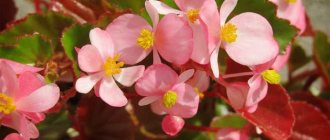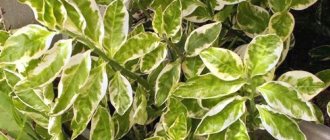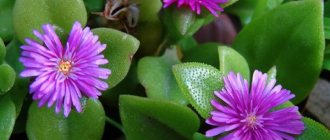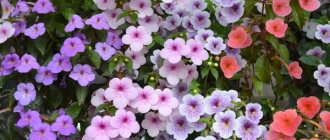Boveya
mountainair.us This succulent looks quite unusual.
The stems that grow from a large bulb are quite long - they can reach a meter. And they will hang freely if you place the boveya on a cabinet or high shelf. And if you place a support in the pot, for example in the shape of a ladder or an arc, the plant stems will entwine it. The flowering of bovea is inexpressive - faded green flowers less than a centimeter appear on it. But this drawback is fully compensated by its unusual appearance.
Where to put
In partial shade. It is better to protect the plant from direct sunlight: this is dangerous for the bulb and stems. Suitable temperature from spring to autumn is 18–25 °C, in winter – 10–15 °C. During a cool winter, the stems die and appear again only when it becomes warm and the plant comes out of dormancy.
How to water
Moderately so that the soil has time to dry out. If kept cool in winter, the plant does not require watering.
Diseases of bulbous plants - possible problems
| Symptoms | Causes | Remedy |
| The plant does not produce leaves or does not bloom | The bulb died as a result of a fungal disease. The affected bulbs become soft to the touch and light. Spring bulbs usually rot after thawing. | Discard the onion and wash the pot thoroughly. Plant bulbous plants in a clean substrate without impurities. |
| The plant has put out leaves, but does not bloom | improper storage, especially at high temperatures, leads to the death of the flowering parts of the bulbs, although the tissues responsible for leaf growth are preserved. Small, weak bulbs may not have enough cells to flower. The presence of rich foliage and sparse flowers may be the result of the use of nitrogen fertilizer | try to buy fresh onions that have not been left on the shelves. Choose large specimens. |
| Leaves appear at the edges of the pot | the bulb or tuber was planted with the top down. | the tops of the bulb or tuber usually have a pointed shape. If you can't tell where the top of the bulb is, it's best to plant it sideways in the ground. |
| Leaves grow slowly, buds fall off without opening | dry air, sudden change in conditions. | increase watering and humidity. Do not move plants during bud stage. |
| The leaves are succulent and grow well, but unopened buds are dropped | too abrupt a transition from cold to warm conditions | Having taken spring-flowering bulbs out of a cold place, send them for 1 week to a cool, but not warm, room. The transition from cold to warm conditions should be gradual. |
| Plants grow large and unstable | too warm conditions at an early stage of growth or lack of light. | place the bulbs close to each other - this will help slow down their growth; place in a cooler room. Do not place in a warm place until the buds begin to open. Light-loving plants are drawn to bright light. |
| Unhealthy leaves, with small yellowish spots | spider mite | Remove affected plants as the mite may spread to other plants |
Valotta
bulbsdirect.co.nz
Valotta is an unpretentious and easy-to-care indoor bulbous plant with narrow leaves approximately 40–50 cm long. It usually blooms once a year - in late summer or autumn. Although this can happen again in the spring. Usually 3–6 flowers with a diameter of about 6–8 cm appear on a high peduncle. You can admire them for about 5–6 days.
Where to put
In diffused bright light. The plant feels normal under morning or evening sunlight, but it must be protected from the midday sun. Comfortable temperature from spring to autumn is 22–25 °C, in winter – 12–15 °C. At any time of the year, you should not leave the valotta in a draft.
How to water
From spring to autumn - as the soil in the pot dries out by about a third. In winter, everything depends on the temperature in the room. The lower it is, the less often watering is needed. It is worth spraying valotta from a spray bottle only during the summer heat, when the temperature rises above 25 °C. It is better to do this early in the morning or late evening so that burns do not appear on the leaves.
Hemanthus
houseplant411.com
Hemanthus is an unpretentious bulbous flower that adapts well to indoor conditions. Its leaves are dark green and dense, their length reaches 20–25 cm, width - 8–10 cm. Because of their shape, the plant is sometimes called “deer tongue”.
Hemanthus blooms in late summer or autumn. The height of the peduncles usually does not exceed 25 cm. The inflorescences of the plant look like fluffy balls. The most popular indoor species, the white-flowered hemanthus, has milky white flowers, while the Katerina hemanthus has deep red ones.
Where to put
In a well-lit place. The plant must be protected from direct sun, otherwise unsightly burn spots will appear on the leaves, and over time they will die off altogether. From spring to autumn, hemanthus feels normal at normal room temperature. And in winter it needs coolness - from 12 to 15 ° C.
How to water
Moderately, the soil in the pot should have time to dry out by about half. Hemanthus does not tolerate stagnation of moisture in the soil and its waterlogging, so it is not worth flooding. High humidity and spraying are not needed.
Why don't they bloom
Often gardeners are faced with a problem common to all bulbous plants - houseplants refuse to bloom. Usually this problem is associated with deficiencies in care and, most often, with the lack of a quality rest period.
In addition, the following possible reasons for the lack of flowering:
- keeping at too low a temperature (do not forget that all bulbs are heat-loving);
- lack of light;
- lack of fertilizing;
- pest damage, diseases.
To cope with the problem, you need to mobilize and intensify care for the plant. It is important to create comfortable conditions for the bulbous flower: warmth, sufficient lighting, nutritious, loose soil; watering should be done moderately and only with warm water.
Also organize regular fertilizing with complex formulations. And to stimulate the plant to bloom and activate its vitality, spray the flower with the following preparations:
So, we got acquainted with the most popular and decorative representatives of bulbous plants used in indoor floriculture. The choice is rich - in the article we listed only some of the worthy representatives of bulbous plants; in fact, a much larger number of them are suitable for home breeding. Graceful bulbs will become a real decoration of the interior, will make any apartment more comfortable and will delight you with magnificent flowering.
Hyacinth
Hyacinth is a bulbous plant that blooms in the spring. Then comes a period of rest. To preserve the flower at this time, you need to carefully remove it from the pot, remove the dried aerial part and store it in a cardboard box at room temperature until autumn. During wintering, when the bulb takes root in the ground, the plant needs coolness - about 7-9 C.
Where to put
In spring, from the beginning of growth to the withering of leaves, on a south, south-east or south-west window.
How to water
Regularly through the tray - during the period from spring awakening and until the leaves remain green. The bulb does not require watering when at rest. Spraying is undesirable at any time of the year.
Planting and transplanting
The beauty and health of an indoor flower depend on the planting material. The best time for planting is autumn. Carefully inspect the bulbs, they should be strong and healthy.
Boarding procedure:
- To disinfect, prepare a 1% solution of potassium permanganate and soak the bulbs in this liquid for half an hour.
- Pay attention to the size of the pot; it should not be much larger than the bulb itself. In large pots, the plant will develop babies, but flowering will not occur.
- Make holes for drainage, add a layer of small pebbles, expanded clay, pebbles, and gravel. Good drainage will prevent the bulbs from rotting.
- Cover with a layer of sphagnum and charcoal, add a layer of soil, place the onion, sprinkle with soil. Do not bury the bulb.
- Water the soil and place the pot in a cool place.
After the leaves appear, transfer to a bright window.
Young plants are transplanted every year into a larger pot, adults – once every few years. If roots are visible from the drainage hole, the plant needs to be replanted. For bulbous plants, the optimal time is the end of the dormant period.
Loose and fertile soil for replanting can be made independently or purchased at a flower shop. The finished soil is formulated taking into account all requirements, is safe, and contains the necessary nutrients. To avoid damaging the root system, use the transshipment method when replanting.
Hippeastrum
Hippeastrum is an indoor bulbous plant with beautiful large flowers, the diameter of which can reach 20 cm. It usually blooms in late winter or spring. At this time, 1–2 arrows with 4–6 buds appear on each bulb.
Breeders have developed many varieties of various colors: with red, orange, white-pink and other bright inflorescences, sometimes decorated with stripes or other “patterns”.
Where to put
On the southeast, east, south or southwest window, so that the plant has enough light and warmth. The temperature from spring to autumn should be room temperature, but during the rest period it should be approximately 10–12 °C.
How to water
Regularly during the period of active growth and flowering, and it is advisable to do this through a tray. Do not overwater: hippeastrum tolerates slight drying out more easily than a swamp in a pot. From the end of September or the beginning of October, it is necessary to gradually increase the intervals between waterings. By the beginning of winter, a period of rest begins, which lasts a couple of months. During cool wintering in a dark place, watering is not necessary.
Zephyranthes
Zephyranthes is an easy-to-care-for bulbous plant that blooms in spring and summer. Its leaves are long and elongated, rich green. The length of the peduncles is approximately 20–25 cm. Each of them bears one yellow, white or pink flower, depending on the species. They grow and develop quickly, literally in a few days.
Where to put
For diffused light, which is needed for abundant flowering. The temperature in the warm season should be 20-24 °C. During dormancy, which occurs in the autumn months (it can be extended until February), the plant needs coolness - no more than 12 ° C - and low light. After this, it is returned to its original place. Zephyranthes can do without rest, but then its flowering will be more modest.
How to water
During growth and flowering - regularly, as soon as the top layer of soil dries out. But you shouldn’t create a swamp in a pot. During the dormant period, it is better to stop watering.
Krinum
Crinum is an unpretentious bulbous indoor plant that is easy to care for. Its leaves are long and flat. The flowers are white-pink or other colors depending on the species. They are quite large in size - up to 10–14 cm in diameter, with 6–10 buds appearing on one peduncle.
Where to put
In a well-lit place - for example, on the windowsills of south, south-east or south-west windows. There is no need to shade the crinum. Due to lack of light, it will not be able to grow normally, and the lower leaves will begin to dry out. Therefore, in winter it is advisable to provide additional lighting. In summer, all crinums are comfortable at 22–27 °C. In winter, tropical species need a temperature of 16–17 °C, and South African species need 3–6 °C.
How to water
Abundantly in the warm season. During wintering, watering should be reduced, but not allowed to dry out completely. Spraying is not needed.
Nerine
flickr.com
Nerine is a bulbous houseplant with long and narrow leaves. Its flowers are pink or white, collected on a high peduncle in umbrellas of several pieces. They appear in the fall - in September or October.
Where to put
In a well-lit place. The temperature suitable for winter is 7–10 °C. At this time, it is better to use additional lighting. In spring and summer, nerine is comfortable at 22–25 °C.
How to water
When flowering and preparing for it - often, but not abundantly, otherwise the bulbs may rot. In winter - a little less often. From spring to late summer, nerine has a dormant period. At this time, watering should be gradually reduced and eliminated, and resumed with the beginning of growth and preparation for flowering.
Irises: growing in open ground
Author: Marina Chaika February 27, 2021 Garden plants
Iris means “rainbow” in Greek. Today this rainbow has more than 700 shades and 35 thousand varieties! But it’s not just the colorful and delicate colors of the cockerels that captivated us: perfumers all over the world value irises for their unique bright aroma.
Did you know that bearded irises are more drought tolerant than their beardless counterparts? That the orris root popular among traditional healers, confectioners and perfumers is actually the root of irises?
We will tell you about these and other secrets of iris in our article.
Why do some irises have no scent? How to save iris from slugs without using chemicals? Do irises need to be covered for the winter? How to prune iris bushes correctly and beautifully after flowering? Why don’t cockerels want to bloom even on “ideal” soil and watering?
Poultry plant (Indian onion)
davesgarden.com
Indian onion is an unpretentious bulbous plant that is easy to care for. Its leaves are long and not very wide, hanging down. The flowers are miniature, greenish in color.
However, the plant gained popularity among many gardeners not for its appearance, but due to its medicinal properties. Poultry plant is quite widely used in folk medicine in the treatment of various diseases. For example, compresses are made from it.
Where to put
In diffused light near a south or east window. The plant will be less comfortable in partial shade. The temperature is suitable at room temperature, the main thing is to protect the poultry from sudden changes and cold.
How to water
Moderately, when the soil on top of the pot begins to dry out. The plant does not tolerate waterlogging well: the roots begin to rot. It is advisable to spray it regularly, especially if the air in the room is dry.
Ledeburia
This plant is able to remain decorative all year round, which is its great advantage. The flowers appear in March-April and are beautiful funnel-shaped bells of a greenish hue.
The plant prefers bright places, so it is better to place it on a southern windowsill. If there is not enough light, the foliage of ledeburia will fade. Air humidity does not matter in this case. The substrate needs to be nutritious and loose; a mixture of leaf soil and humus is considered optimal.
Care is simple: watering is moderate, fertilizing is required. The plant especially needs potassium, which ensures good growth and long flowering. In summer, you can take the pot out into the garden, but ledeburia will not survive low temperatures - not lower than +7 degrees.
Eucharis
Jan Smith
Eucharis is a popular bulbous houseplant. Its leaves are large, about 15–20 cm wide and up to 40 cm long. The flowers are milky white, fragrant and large, up to 10 cm in diameter. With proper care, flowering occurs several times a year.
Where to put
For any window sill, even the northern one. The plant tolerates light partial shade. In summer it is worth protecting it from direct sunlight. At room temperature the flower is quite comfortable; cold maintenance is not necessary in the winter months.
How to water
Regularly, as the soil dries. Spraying is also useful.











